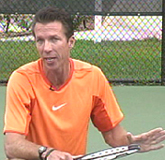World Class Movement:
An Overview
David Bailey
Tennis is a dance, and the ball is your partner. I have said this for years, and now in this new series of articles for Tennisplayer, I want to demonstrate exactly what that dance looks like off the ground at the pro level--and how you can develop a similar groundstroke dance of your own.
In this first article I want to outline the components of world class movement and then the specific athletic skills required to develop them. In a second article I will summarize my work on the critical, often unrecognized concept of the "contact move," the dynamic action of the feet and body during the ball striking phase.
In future articles, I will turn the analysis to the actual movement patterns of the world's best players as they cover the court from sideline to side in some incredible Tennisplayer high speed video sequences—and see how the concepts we are outlining are applied. We'll start those articles with Roger Federer, but then move on to Rafa Nadal and Novak Djokovic.
Finally, in later articles we will address the right movement options for the average player by looking at the situations you face on the court and what is required to develop world class patterns of footwork for yourself.
A Common Language
One of the problems today in playing and coaching is the lack of a common language in the critical area of movement. My work has been devoted to trying to help create this framework, developing terminology for the complexity and variety of what actually happens on the court in high level pro matches. But beyond that understanding I have sought as a teacher and coach to help players of all abilities develop the best possible movements patterns at their level of play.
5 Components
I believe great movement in tennis at any level has five components. These are what I call the 5R's. I call putting these 5R's together Completing the Circle, something that should happen with every ball match in and match out.
The 5R's are:
| 1. | Ready. Being ready means have your weight up, on the toes and the balls of your feet, and then split stepping to create a strong foundation. |
| 2. | Reading. Reading means seeing and recognizing the trajectory of the incoming ball, anticipating it's landing, and developing the timing to move to and to meet the ball in the contact zone. |
| 3. | Reacting. Reacting means initiating the movement correctly through a variety of possible initial steps—what I call Out Steps--and then setting up an appropriate hitting stance. |
| 4. | Responding. Responding refers to the actual movement of the feet and body during the contact sequence. These movements are what I call Contact Moves. They vary with the court position, the nature of the incoming ball, and the intent of the player. Each Contact Move has a corresponding Balance Move to maintain dynamic balance through the movement. |
| 5. | Recovery. Recovery includes the Braking Steps to slow down and reverse the movement, and then the actual pattern of Recovery Steps returning toward the midpoint of your opponent's next shot. |
Six Skills
When we study the pro game, we can see that executing the 5Rs and Completing the Circle requires certain physical skills. These 6 basic skills are the ability to:
| 1. | Pivot the Hips on the ground. |
| 2. | Spin the Hips in the air. |
| 3. | Shift the Weight from the back to the front foot. |
| 4. | Transfer the Weight in the air. |
| 5. | Execute Multi-Directional Hopping forward, sideways, vertically, and backward. |
| 6. | Take Large Lunging Steps on a forward diagonal. |
These 6 skills are the basis for the creation of the critical Contact Moves. Just as John Yandell's work has shown the incredible dynamism and variety in the swings themselves, this analysis of the range and variety of Contact Moves is critical in describing, understanding and developing world class movement.
Many footwork articles concentrate on the importance of split stepping, first step quickness, stances, etc. But these concepts alone are insufficient to explain what really happens in world class movement. Specifically, they miss the critical Contact Moves and the corresponding Balance Moves.
Contact Moves are the actual movements aplayers makes when making contacting the ball—using the six athletic skills to create the most effective and efficient stroke possible.
Video research has established that there are actually 15 distinct Contact Moves that can be divided into four categories: Attacking, Building, Counter-Attacking and Defensive Contact Moves.
Long time subscribers of Tennisplayer may remember my previous multiple part articles identifying the Contact Moves and their characteristics with video examples of elite pro players. That material is available in the footwork section of the site in a series of detailed articles. (Click Here.) But in the next article I will attempt to briefly summarize them as well.
Armed with this conceptual understanding we can then look at what is really happening on the tour in all its power, beauty and complexity. Not to mention learn how to incorporate those same principles for yourself.
Stay tuned.




